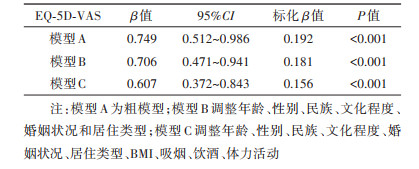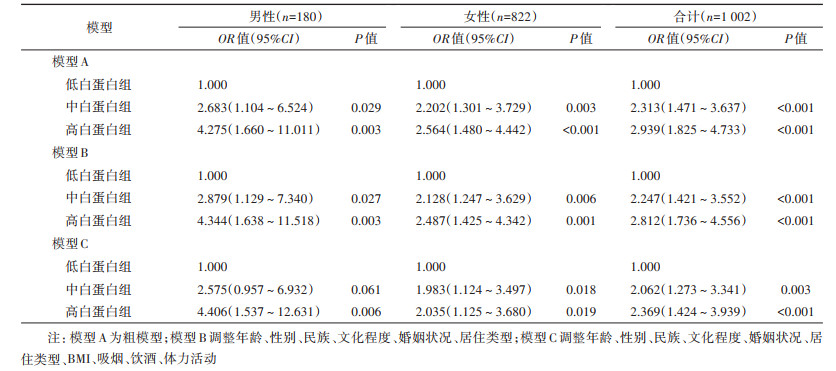文章信息
- 韩珂, 王盛书, 贾王平, 杨姗姗, 曹文哲, 赵亚力, 朱乔, 甯超学, 刘淼, 何耀.
- Han Ke, Wang Shengshu, Jia Wangping, Yang Shanshan, Cao Wenzhe, Zhao Yali, Zhu Qiao, Ning Chaoxue, Liu Miao, He Yao
- 海南百岁老人血清白蛋白水平与健康相关生活质量的关联性研究
- Association between serum albumin level and health-related quality of life in Hainan centenarians: a cross-sectional study
- 中华流行病学杂志, 2021, 42(1): 88-93
- Chinese Journal of Epidemiology, 2021, 42(1): 88-93
- http://dx.doi.org/10.3760/cma.j.cn112338-20200424-00637
-
文章历史
收稿日期: 2020-04-24
2. 解放军总医院海南医院中心实验室, 三亚 572013;
3. 解放军总医院研究生院统计与流行病学教研室, 北京 100853
2. Central Laboratory of Hainan Hospital, Chinese People's Liberation Army General Hospital, Sanya 572013, China;
3. Department of Statistics and Epidemiology, Graduate School, Chinese People's Liberation Army General Hospital, Beijing 100853, China
我国是世界上老龄人口规模最大的国家,也是世界上老龄化速度最快的国家[1]。快速的老龄化导致老年人的患病、失能、失智和健康相关生活质量下降等问题,对社会经济发展、健康与疾病流行模式、居民生活方式均带来巨大影响[2]。健康的老龄化是指老年人在生物-心理-社会全方位的健康[3-4]。健康相关生活质量(health-related quality of life,HRQoL)是评价个体日常活动和生理功能状态以及其在情绪和社会生活方面主观满意度的综合指标[5]。在老年人群中,HRQoL综合反映了与健康有关的因素,对研究老年人群生存状态和生活质量有重要意义。血清白蛋白(serum albumin,Alb)是人体中含量最丰富的血浆蛋白,具有重要的生理功能。低白蛋白血症与机体营养不良、炎症、感染等有关[6-8]。既往研究表明,低白蛋白水平与老年人日常活动能力和认知功能下降有关[9-10],并且可作为老年人死亡的独立预测因素[8, 11-12]。目前针对老年人群白蛋白水平和健康相关生活质量的研究鲜有报道,且多集中在医院人群和特定疾病人群,多关注较年轻的老年群体,基于社区高龄及百岁人群的大样本证据较少。因此,本研究利用中国海南百岁老人队列研究(China Hainan Centenarian Cohort Study,CHCCS)的数据集,分析和探讨百岁老人中白蛋白水平与健康相关生活质量的关联。
对象与方法1.研究对象:本研究数据来自CHCCS 2014- 2016年横断面数据集。CHCCS是基于中国海南省社区人群的前瞻性队列研究。CHCCS的抽样框架与研究方法见既往报道[13]。CHCCS的基线调查人群包括海南省≥100岁的男性和女性个体1 473人。2014-2016年横断面数据集中,剔除部分失访对象(死亡、无法联系、搬迁、住院等)和拒绝参与者,本研究最终纳入1 002人进行分析。
2.调查内容和方法:调查内容主要包括问卷调查、体格检查、生物标本的采集和实验室检查。所有调查问卷由经过系统培训的护士以海南方言进行面对面访谈,同时收集一般人口学特征、家庭经济状况、行为生活方式、个人和家族疾病史、认知和心理健康状况以及功能状态等项目。健康相关生活质量采用自评量表,由调查对象或其最亲近的照料者对相关问题进行回答。由具有 > 5年工作经验的老年科、心内科、耳鼻喉科医生、口腔科、妇科、超声科医师和训练有素的护士组成多学科团队,完成体格检查和生物标本采集。体格检查包括血压测量、人体测量、视听觉、老年综合征、心电图、超声、牙科检查和妇科检查等。生物标本采集包括血液、口腔黏膜、粪便等标本,血液标本采集后立即冷藏并于6 h内运至中国人民解放军总医院海南分院检验科进行实验室检测。体格检查和标本采集与问卷调查同时进行,调查结果通过EpiData 3.1软件由双人交叉核对录入。
3.相关指标及定义:调查百岁老人的基本情况,包括年龄、性别、身高、体重、民族、文化程度、城乡居住、婚姻状况、吸烟、饮酒、体力活动状况及其体检和实验室检查指标等。采用EQ-5D-VAS量表测量健康相关生活质量。EQ-5D量表是在欧洲地区开发并广泛使用的用于描述和评估健康状况的通用工具[14-15],涵盖了行动能力、自我照料、日常活动、疼痛/不适和焦虑/抑郁5个维度的问题,每个维度又包含3个水平:没有任何困难、有些困难、有极度困难。使用EQ-5D指数得分描述健康相关生活质量,因目前还没有基于我国人群的专用EQ-5D效用值换算表,所以本研究采用日本基于时间权衡(time trade-off,TTO)模型的积分换算表计算EQ-5D指数得分[16-17]。此换算表产生的分值介于-0.11~1.00之间,将得分 < 1即存在任何一个维度的EQ-5D异常定义为健康相关生活质量受损。VAS(视觉模拟量表)是一种自我评估工具,受访者在20 cm的垂直刻度尺上评估健康状况,顶部的100分表示最佳健康状况,底部的0分表示最差健康状况。
4.统计学分析:数值变量资料采用x±s或中位数(四分位数)描述,分类变量资料采用n(%)描述。组间比较连续变量采用Kruskal Wallis秩和检验,分类变量采用χ2检验。应用多重线性回归分析白蛋白水平与VAS得分的关系。根据性别分层,分别以白蛋白连续变量和三分类变量作为自变量,应用logistic回归模型计算白蛋白水平与健康相关生活质量受损的OR值。统计分析使用R3.4.3软件完成,以双侧P < 0.05作为差异有统计学意义的检验水平。
结果1.一般情况:共纳入1 002名百岁老人,其中女性822人,占82.04%。年龄在100~116岁之间,中位年龄为102(101~104)岁。以汉族、文盲、丧偶/离异/未婚、与家人同住为主。超过80.0%者从不吸烟与饮酒,没有每周进行体力活动的习惯。血清白蛋白水平为(38.43±3.99) g/L,EQ-5D指数得分的中位水平为0.65(0.59~0.73),VAS得分水平为(61.60±15.56)。样本中873名百岁老人(143名男性和730名女性)EQ-5D指数得分 < 1,健康相关生活质量受损率为87.13%。低白蛋白水平人群中每周进行体力活动的老年人更少,且具有更低的BMI、EQ-5D换算得分和VAS得分(P < 0.01)。见表 1。
2.血清白蛋白水平与VAS得分的线性回归:血清白蛋白连续变量作为自变量纳入模型,对人口统计学特征和生活方式包括年龄、性别、民族、文化程度、婚姻状况、居住类型、BMI、吸烟、饮酒和体力活动逐步进行调整。血清白蛋白与VAS得分之间存在正向线性关系,逐步纳入协变量,标准化β值分别为0.192、0.181、0.156(P < 0.001)。见表 2。
3.血清白蛋白水平与健康相关生活质量受损的logistic回归:血清白蛋白作为自变量,健康相关生活质量受损作为因变量纳入模型,逐步调整年龄、性别、民族、文化程度、婚姻状况、居住类型、BMI、吸烟、饮酒和每周体力活动,进行多元logistic回归分析。将血清白蛋白按三分位数进行分类变量处理,分为低、中、高白蛋白水平组,作为自变量纳入模型,与高白蛋白水平组相比,中白蛋白水平组在各模型中的OR值分别为2.313(95%CI:1.471~ 3.637)、2.247(95%CI:1.421~3.552)、2.062(95%CI:1.273~3.341),低白蛋白水平组在各模型中的OR值分别为2.939(95%CI:1.825~4.733)、2.812(95%CI:1.736~4.556)、2.369(95%CI:1.424~3.939)。
在百岁老人中按性别进行分层分析,低血清白蛋白水平对健康相关生活质量受损的风险增加仍然显著。在完全调整各协变量的模型C中,与高白蛋白水平组相比,中白蛋白水平组健康相关生活质量受损的风险在女性百岁老人中为1.983倍(95%CI:1.124~3.497),在男性百岁老人中为2.575倍(95%CI:0.957~6.932);低白蛋白水平组健康相关生活质量受损的风险在女性百岁老人中为2.035倍(95%CI:1.125~3.680),在男性百岁老人中为4.406倍(95%CI:1.537~12.631)。见表 3。
本研究通过CHCCS数据库2014-2016年横断面数据描述了百岁老人血清白蛋白水平、健康相关生活质量的现况并进行了两者的相关性研究。在1 002名百岁老人中,健康相关生活质量的受损率为87.13%。研究首次发现,百岁老人中血清白蛋白与EQ-5D指数得分和VAS得分之间存在正向线性关系,低白蛋白水平是健康相关生活质量受损的风险因素,且该效应在男性百岁老人中更加明显。
本研究中海南百岁老人的血清白蛋白水平为(38.43±3.99) g/L。这较CLHLS数据库同类研究结果报道的高龄老人血清白蛋白水平低[18]。这可能与研究对象的年龄分布特点不同有关。既往研究表明血清白蛋白水平与衰老有关,以每年0.08~0.17 g/L逐渐降低[8]。本研究人群中仅有12.87%的百岁老人在EQ-5D涉及的行动能力、自我照料、日常活动、疼痛/不适和焦虑/抑郁5个方面均评价良好。与 > 60岁年龄组的老年人相比[19-20],百岁老人的EQ-5D指数得分和VAS得分更低,这可能与年龄相关的日常活动能力下降及老年综合征的影响相关。
百岁老人被认为是健康老龄化和长寿的模板人群[21],与通常寻找“危险”因素不同,百岁老人研究可以探索和确定与年龄相关的主要疾病和不良结局有关的遗传或环境保护因素[22]。血清白蛋白与许多疾病相关,与年龄相关疾病关联密切,是影响老年人日常活动能力、认知功能和死亡的重要因素。本研究发现,百岁老人的血清白蛋白水平降低与该人群健康相关生活质量下降相关,血清白蛋白是健康相关生活质量受损的保护因素。既往研究表明[8],白蛋白浓度与衰老有关,其中男性的下降速度往往快于女性。既往有研究报道,在接受肝移植患者[23]和维持性血液透析患者[24]中血清白蛋白水平与健康相关生活质量相关,但在一般人群和百岁老人中未见相关报道。
血清白蛋白在维持机体功能中起着重要的生理作用,包括维持血浆胶体渗透压、运输内源性物质和外源性药物等,其与健康相关生活质量的相关性可能有以下解释。一方面,血清白蛋白水平是临床评定人群营养状况的良好标志,蛋白质-热量营养不良与生活质量下降密切相关[25-26]。例如,在白蛋白水平低的老年人中观察到肌肉质量显著减少,并导致日常活动能力的下降[27],进而影响生活质量。另一方面,白蛋白水平与炎症状态密切相关,并在器官或系统功能障碍/衰竭的发病机制中发挥重要作用,低白蛋白血症相关的炎性状态和不良的急性病理恢复是老年人失能的危险因素[28],将严重影响老年人健康相关生活质量。
本研究具有一定的局限性。第一,研究中对健康相关生活质量的调查采取现场问卷的形式,对于总体认知功能较差的老年人群的自报结果可能存在部分信息偏倚。其次,部分拒绝或无法完成调查和身体检查的老年人未纳入本分析样本,而这些研究对象可能处于较低水平的健康状况和认知功能,这可能导致对分析样本人群健康相关生活质量的高估。第三,本研究为横断面调查,对百岁老人血清白蛋白水平与健康相关生活质量的分析仅为关联研究,两者的因果时序关系及内在机制难以判别,需要前瞻性的队列研究进一步验证。第四,本研究人群为海岛环境下的大样本百岁老人,结论外推需要谨慎。
综上所述,本研究基于CHCCS调查数据的分析,发现在百岁老人中较低水平的血清白蛋白水平与健康相关生活质量受损风险升高有关。关注低白蛋白血症人群的健康状况,对提高老人健康相关生活质量,实现健康老龄化有着重要意义。
利益冲突 所有作者均声明不存在利益冲突
| [1] |
United Nations. World population ageing 2013[R]. New York: United Nations, ST/SEA/SER.A/348, 2013.
|
| [2] |
何耀, 杨姗姗. 健康老龄化与老年流行病学研究进展[J]. 中华流行病学杂志, 2018, 39(3): 253-257. He Y, Yang SS. Healthy aging and the progress in the research of geriatric epidemiology[J]. Chin J Epidemiol, 2018, 39(3): 253-257. DOI:10.3760/cma.j.issn.0254-6450.2018.03.001 |
| [3] |
Depp CA, Jeste DV. Definitions and predictors of successful aging:a comprehensive review of larger quantitative studies[J]. Am J Geriatr Psychiatry, 2006, 14(1): 6-20. DOI:10.1097/01.JGP.0000192501.03069.bc |
| [4] |
Motta M, Bennati E, Ferlito L, et al. Successful aging in centenarians:myths and reality[J]. Arch Gerontol Geriatr, 2005, 40(3): 241-251. DOI:10.1016/j.archger.2004.09.002 |
| [5] |
Karimi M, Brazier J. Health, health-related quality of life, and quality of life:what is the difference?[J]. Pharmaco Economics, 2016, 34(7): 645-649. DOI:10.1007/s40273-016-0389-9 |
| [6] |
Baumgartner RN, Koehler KM, Romero L, et al. Serum albumin is associated with skeletal muscle in elderly men and women[J]. Am J Clin Nutr, 1996, 64(4): 552-558. DOI:10.1093/ajcn/64.4.552 |
| [7] |
Soeters PB, Wolfe RR, Shenkin A. Hypoalbuminemia:pathogenesis and clinical significance[J]. JPEN J Parenteral Enteral Nutr, 2019, 43(2): 181-193. DOI:10.1002/jpen.1451 |
| [8] |
Cabrerizo S, Cuadras D, Gomez-Busto F, et al. Serum albumin and health in older people:Review and Meta analysis[J]. Maturitas, 2015, 81(1): 17-27. DOI:10.1016/j.maturitas.2015.02.009 |
| [9] |
Onem Y, Terekeci H, Kucukardali Y, et al. Albumin, hemoglobin, body mass index, cognitive and functional performance in elderly persons living in nursing homes[J]. Arch Gerontol Geriatr, 2010, 50(1): 56-59. DOI:10.1016/j.archger.2009.01.010 |
| [10] |
Taniguchi Y, Shinkai S, Nishi M, et al. Nutritional biomarkers and subsequent cognitive decline among community-dwelling older Japanese:a prospective study[J]. J Gerontol A Biol Sci Med Sci, 2014, 69(10): 1276-1283. DOI:10.1093/gerona/glt286 |
| [11] |
Liu ZY, Zhong GZ, Li SJ, et al. Use of serum albumin and activities of daily living to predict mortality in long-lived individuals over 95 years of age:a population-based study[J]. AGE (Dordr), 2015, 37(4): 73. DOI:10.1007/s11357-015-9809-6 |
| [12] |
Okamura T, Hayakawa T, Hozawa A, et al. Lower levels of serum albumin and total cholesterol associated with decline in activities of daily living and excess mortality in a 12-year cohort study of elderly Japanese[J]. J Am Geriatr Soc, 2008, 56(3): 529-535. DOI:10.1111/j.1532-5415.2007.01549.x |
| [13] |
He Y, Zhao YL, Yao Y, et al. Cohort profile:The China Hainan Centenarian Cohort Study (CHCCS)[J]. Int J Epidemiol, 2018, 47(3): 694-695. DOI:10.1093/ije/dyy017 |
| [14] |
The EuroQol Group. EuroQol-a new facility for the measurement of health-related quality of life[J]. Health Policy, 1990, 16(3): 199-208. DOI:10.1016/0168-8510(90)90421-9 |
| [15] |
Herdman M, Gudex C, Lloyd A, et al. Development and preliminary testing of the new five-level version of EQ-5D (EQ-5D-5L)[J]. Qual Life Res, 2011, 20(10): 1727-1736. DOI:10.1007/s11136-011-9903-x |
| [16] |
Feng Y, Herdman M, van Nooten F, et al. An exploration of differences between Japan and two European countries in the self-reporting and valuation of pain and discomfort on the EQ-5D[J]. Qual Life Res, 2017, 26(8): 2067-2078. DOI:10.1007/s11136-017-1541-5 |
| [17] |
Tsuchiya A, Ikeda S, Ikegami N, et al. Estimating an EQ-5D population value set:the case of Japan[J]. Health Econom, 2002, 11(4): 341-353. DOI:10.1002/hec.673 |
| [18] |
殷召雪, 王静雷, 吕跃斌, 等. 中国8个长寿地区65岁及以上老年人群血浆白蛋白水平与认知功能关系的研究[J]. 中华流行病学杂志, 2016, 37(10): 1323-1326. Yin ZX, Wang JL, Lyu YB, et al. Association between serum albumin and cognitive performance in elderly Chinese[J]. Chin J Epidemiol, 2016, 37(10): 1323-1326. DOI:10.3760/cma.j.issn.0254-6450.2016.10.001 |
| [19] |
Shiroiwa T, Fukuda T, Ikeda S, et al. Japanese population norms for preference-based measures:EQ-5D-3L, EQ-5D-5L, and SF-6D[J]. Qual Life Res, 2016, 25(3): 707-719. DOI:10.1007/s11136-015-1108-2 |
| [20] |
Pan CW, Cong XL, Zhou HJ, et al. Self-reported sleep quality, duration, and health-related quality of life in older Chinese:evidence from a rural Town in Suzhou, China[J]. J Clin Sleep Med, 2017, 13(8): 967-974. DOI:10.5664/jcsm.6696 |
| [21] |
Perls TT, Silver MH, Lauerman JF. Living to 100:lessons in living to your maximum potential at any age[M]. New York: Basic Books, 1999.
|
| [22] |
Franceschi C, Passarino G, Mari D, et al. Centenarians as a 21st century healthy aging model:A legacy of humanity and the need for a world-wide consortium (WWC100+)[J]. Mech Ageing Dev, 2017, 165(Pt B): 55-58. DOI:10.1016/j.mad.2017.06.002 |
| [23] |
Jara M, Bednarsch J, Malinowski M, et al. Predictors of quality of life in patients evaluated for liver transplantation[J]. Clin Trans, 2014, 28(12): 1331-1338. DOI:10.1111/ctr.12426 |
| [24] |
Kalantar-Zadeh K, Kopple JD, Block G, et al. Association among SF36 quality of life measures and nutrition, hospitalization, and mortality in hemodialysis[J]. J Am Soc Nephrol, 2001, 12(12): 2797-2806. |
| [25] |
Crogan NL, Pasvogel A. The influence of protein-calorie malnutrition on quality of life in nursing homes[J]. J Gerontol A Biol Sci Med Sci, 2003, 58(2): M159-164. DOI:10.1093/gerona/58.2.m159 |
| [26] |
Rambod M, Bross R, Zitterkoph J, et al. Association of Malnutrition-Inflammation Score with quality of life and mortality in hemodialysis patients:a 5-year prospective cohort study[J]. Am J Kidney Dis, 2009, 53(2): 298-309. DOI:10.1053/j.ajkd.2008.09.018 |
| [27] |
Yoshimura Y, Uchida K, Jeong S, et al. Effects of nutritional supplements on muscle mass and activities of daily living in elderly rehabilitation patients with decreased muscle mass:a randomized controlled trial[J]. J Nutr Health Aging, 2016, 20(2): 185-191. DOI:10.1007/s12603-015-0570-4 |
| [28] |
Arroyo V, García-Martinez R, Salvatella X. Human serum albumin, systemic inflammation, and cirrhosis[J]. J Hepatol, 2014, 61(2): 396-407. DOI:10.1016/j.jhep.2014.04.012 |
 2021, Vol. 42
2021, Vol. 42





